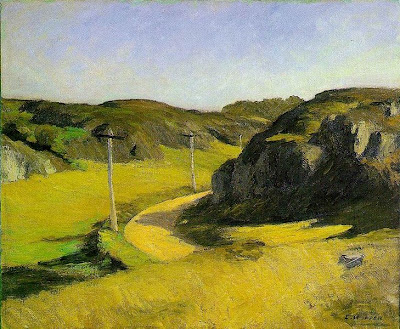Lessons in Restraint from Edward Hopper

Here's an oil by the famous 2oth century American painter Edward Hopper, Road in Maine.
Hopper was a bold painter, famous for his strong lights and shadows. But his genius more often lay in how he held back from high contrasts. Just as you need silence to appreciate a loud noise, you need quiet passages to let the drama that is there have a weighty impact. Here are some examples of Hopper's elegant restraint.
First, it's a mostly yellow painting (though in the form of yellow ochre-greens). The sky has blue in it, but not that much. Hopper has held back on the amount and intensity of his blue to keep the emphasis on the ground. The blues in the sky are knocked back into a subordinate role. I can't tell you how many times I've seen less experienced landscape painters paint vibrantly colorful skies that compete with the ground they've painted. Here Hopper says he wants you to look at the ground.
He gives us two hillsides and a valley. Look at the top edges of both the close and far hills. Their silhouette against the sky and/or against the valley is a hard, sharp line. Hopper has carefully created an outer contour for each hill that is expressive. To make sure you notice them he's toned down the contrasts within the centers of each hill.
Hopper's grasses are wheat-colored, suggesting it's late in the season. Except for the cast shadows, the grasses hardly change in color. The foreground field is quite close to us, yet there aren't lots on individual strands of long grasses sticking up. In fact, there's none. What he does give us is a foreground where the strokes still show. In comparison, the farther field, almost the exact same color, has barely visible strokes. And the ones that do show suggest he's moving his brush horizontally, unlike the left-leaning diagonals in the foreground brushwork.
Wonderful details that add much to the painting are the three telephone poles. Hopper chose to make them partly yellow like his fields, but at a much lowered intensity. They read as almost white and accentuate the feeling of the color in the far field. Hold your finger over the largest pole and see how the surrounding yellows in the field seem heavier and less sensuous. And he's figured the wires hanging between each pole would be too fussy to include and eliminated them.


